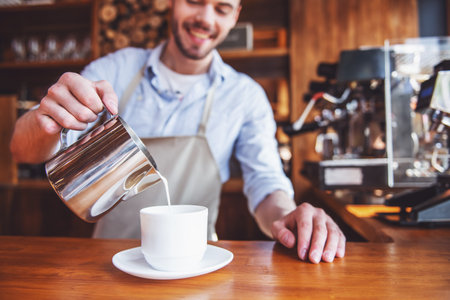1. Understanding Coffee Roasting: From Green Bean to Brew
Before your morning cup of coffee ever hits your mug, it starts as a small, green bean with very little flavor or aroma. It’s the roasting process that transforms these raw beans into the rich, aromatic coffee we know and love. Roasting is both a science and an art — its where chemistry meets craftsmanship.
What Happens During Coffee Roasting?
When green coffee beans are exposed to high heat during roasting, they undergo a series of complex chemical reactions. These reactions bring out the flavor, aroma, and color of the final coffee. Here are some key changes that happen:
| Roasting Stage | Main Changes | Flavor Impact |
|---|---|---|
| Drying Phase | Evaporation of moisture; bean temperature rises slowly | No major flavor yet; prepares for chemical changes |
| Browning Phase | Maillard reaction begins; sugars and amino acids react | Development of nutty, caramel-like flavors |
| First Crack | Beans expand and crack audibly; rapid flavor development | Acidity, sweetness, and aroma emerge |
| Second Crack (in darker roasts) | Oils move to surface; more carbonization | Bitter, smoky, and bold flavors increase |
Why Roasting Level Matters
The degree to which a coffee bean is roasted — light, medium, or dark — has a major impact on its taste profile. Light roasts preserve more of the bean’s natural acidity and origin flavors. Medium roasts strike a balance between acidity and body. Dark roasts emphasize bitterness and boldness while muting unique origin characteristics.
Common Roast Levels and Their Taste Characteristics
| Roast Level | Color | Taste Notes |
|---|---|---|
| Light Roast | Light brown | Bright acidity, fruity or floral notes, lighter body |
| Medium Roast | Medium brown | Smooth balance of acidity and body, chocolatey or nutty tones |
| Dark Roast | Dark brown to almost black with oily surface | Bitter, smoky, low acidity, heavier body |
The Role of Time and Temperature in Roasting
The time spent roasting and the temperature applied determine how far a roast develops. A quick roast at high temperatures can result in uneven development, while a slower roast allows for more control over flavor balance. Expert roasters adjust these variables based on the desired outcome.
The science behind coffee roasting is essential because it unlocks the potential within each bean. Whether youre sipping a bright Ethiopian light roast or a bold French roast from Sumatra, every cup tells the story of how it was roasted.
2. The Science of Roasting: Chemical Reactions in the Roaster
When coffee beans are roasted, they undergo a series of complex chemical reactions that transform their raw, green form into the aromatic and flavorful beans we brew every day. Understanding these processes can help explain why different roasting levels produce such distinct tastes and aromas.
The Maillard Reaction: Where Flavor Begins
The Maillard reaction is one of the most important chemical changes during coffee roasting. It starts when the beans reach around 300°F (150°C). This reaction happens between amino acids and reducing sugars, leading to the formation of hundreds of new flavor compounds. These compounds give roasted coffee its deep, rich flavors like nuttiness, toastiness, and even chocolatey notes.
Key Characteristics of the Maillard Reaction:
| Temperature Range | Flavor Impact | Aroma Notes |
|---|---|---|
| 300°F – 350°F (150°C – 175°C) | Rich, savory, complex flavors | Nuts, bread, malt |
Caramelization: Sweetness and Color
As roasting continues and temperatures climb above 370°F (188°C), sugars in the coffee begin to caramelize. Caramelization breaks down sugar molecules and creates sweet, buttery, and syrupy flavors. This stage also darkens the color of the bean and contributes to a smoother mouthfeel in darker roasts.
Caramelization Breakdown:
| Temperature Range | Sugar Transformation | Taste Profile |
|---|---|---|
| 370°F – 400°F (188°C – 204°C) | Sugars break down into caramel-like compounds | Sweet, buttery, smooth |
Other Key Processes: First Crack and Beyond
Around 385°F (196°C), beans experience whats known as “first crack”—a popping sound signaling that water inside the bean has turned to steam, causing expansion. This marks the transition from light to medium roast. As roasting progresses past this point, oils start moving to the surface of the bean, especially noticeable in dark roasts.
Stages of Bean Transformation:
| Stage | Description | Taste Impact |
|---|---|---|
| First Crack (~385°F / ~196°C) | Beans expand and emit popping sounds; interior starts developing flavor | Bright acidity, floral or fruity notes emerge |
| Second Crack (~435°F / ~224°C) | Louder cracks; cell walls break down further; oils reach surface | Bolder, smokier flavors with reduced acidity |
Each chemical reaction in the roasting process plays a unique role in shaping your cup of coffee. By adjusting roast levels, roasters can highlight specific taste characteristics—from bright and fruity to dark and bold—all depending on how long and how hot the beans are roasted.

3. Light, Medium, and Dark Roasts: What Sets Them Apart
When it comes to coffee roasting, the roast level plays a huge role in how your cup of coffee smells, tastes, and even looks. In the U.S., coffee drinkers often have strong preferences when it comes to roast levels—some love the bright acidity of a light roast, while others prefer the bold richness of a dark roast. Let’s break down what makes each roast level unique by looking at color, oil presence on the bean, and flavor notes commonly recognized in American coffee culture.
Roast Level Comparison
| Roast Level | Color | Surface Oil | Common Flavor Notes (U.S. Preferences) |
|---|---|---|---|
| Light Roast | Light brown | No visible oil | Citrus, floral, tea-like, high acidity |
| Medium Roast | Medium brown | No or minimal oil | Balanced acidity and body, caramel, chocolatey tones |
| Dark Roast | Dark brown to almost black | Oily surface | Bitter-sweet chocolate, smoky, nutty, low acidity |
Light Roasts: Bright and Complex
Light roasts are roasted for a shorter amount of time and usually pulled right after the “first crack” stage during roasting. These beans retain much of their original flavor profile from the origin country. Because there’s no oil on the surface, they appear dry and have a lighter color. Americans who enjoy single-origin coffees or pour-over methods often prefer light roasts for their complex flavors and higher caffeine content per scoop.
Taste Highlights:
- High acidity with fruity or floral notes
- Lighter body with more clarity in flavor
- Great for showcasing bean origin characteristics
Medium Roasts: The Balanced Favorite
This is often referred to as the “American roast” because its widely preferred across the United States. Medium roasts offer a balanced cup that brings together both origin characteristics and roasted flavor notes. The beans are medium brown and typically dry or only slightly oily. This roast level works well for drip coffee machines and French press styles commonly found in American households.
Taste Highlights:
- Mellow acidity with smooth body
- Sweeter notes like caramel or milk chocolate
- A go-to choice for daily coffee drinkers in the U.S.
Dark Roasts: Bold and Smoky
Dark roasts are roasted past the second crack, leading to beans that are visibly shiny due to surface oils. These beans have less of their original flavor profile and instead offer rich, toasted flavors from the roasting process itself. Many American espresso blends use dark roasts to create intense flavor and crema. This style is also common among those who enjoy strong-tasting brews like cold brew or café-style lattes.
Taste Highlights:
- Low acidity with full-bodied mouthfeel
- Bitter-sweet notes like dark chocolate or burnt sugar
- Smooth but intense—ideal for milk-based drinks
Understanding these differences can help you pick the perfect roast based on your taste preferences or brewing method. Whether youre into bright and fruity or bold and smoky, theres a roast level out there that’s just right for your morning cup.
4. How Roast Level Impacts Flavor Profile and Acidity
When it comes to coffee, roast level plays a huge role in how your cup tastes. From light to dark roasts, each level changes the way we experience sweetness, bitterness, body, and acidity. Understanding these differences can help you pick the roast that best suits your taste preferences.
Sweetness vs. Bitterness
Roasting transforms the sugars in coffee beans. In lighter roasts, more natural sugars remain intact, which gives the coffee a noticeable sweetness. As the roast gets darker, those sugars start to break down and turn into bitter compounds.
| Roast Level | Sweetness | Bitterness |
|---|---|---|
| Light Roast | High | Low |
| Medium Roast | Balanced | Moderate |
| Dark Roast | Low | High |
Body of the Coffee
The “body” refers to how heavy or full the coffee feels in your mouth. Lighter roasts usually have a thinner body with a tea-like texture, while darker roasts feel heavier and richer due to chemical changes during roasting.
| Roast Level | Mouthfeel / Body |
|---|---|
| Light Roast | Light and crisp |
| Medium Roast | Smooth and balanced |
| Dark Roast | Bold and full-bodied |
Acidity Levels Explained
Coffee acidity isnt about sourness—its more like brightness or tanginess, similar to fruit flavors. Light roasts tend to have higher acidity because they retain more of the bean’s original characteristics. As roasting progresses, this acidity decreases.
| Roast Level | Acidity Level | Tasting Notes Often Found |
|---|---|---|
| Light Roast | High | Citrus, berries, floral notes |
| Medium Roast | Moderate | Nuts, chocolate, mild fruits |
| Dark Roast | Low | Smoky, toasted, bittersweet chocolate |
The Big Picture: Finding Your Perfect Cup
Your ideal roast level depends on what you enjoy most in a cup of coffee. If youre into bright and fruity flavors with a lighter feel, light roasts might be your go-to. For those who prefer a bold, rich cup with lower acidity and more bitterness, dark roasts are the way to go. Medium roasts strike a balance and are often favored for their rounded flavor profile.
No matter what your preference is, understanding how roast levels affect taste can make your next coffee choice even more enjoyable.
5. Choosing the Right Roast for Your Brew Method
Not all roast levels are created equal—especially when it comes to how you brew your coffee. In the U.S., popular brewing methods like drip coffee, pour-over, espresso, and cold brew each bring out different qualities in a roast. Choosing the right roast for your preferred method can make a big difference in flavor, aroma, and overall experience.
Matching Roast Levels with Brewing Styles
The table below breaks down which roast levels typically work best with each common American brewing method:
| Brew Method | Recommended Roast Level | Flavor Highlights |
|---|---|---|
| Drip Coffee (Auto Drip) | Medium to Medium-Dark | Balanced body and acidity; chocolatey or nutty notes |
| Pour-Over (e.g., Chemex, Hario V60) | Light to Medium | Bright acidity; more complex and delicate flavors |
| Espresso | Medium-Dark to Dark | Bold, rich body; low acidity with caramelized sweetness |
| Cold Brew | Medium to Dark | Smooth, mellow taste; lower acidity and bitterness |
Why Roast Level Matters by Brew Method
Drip Coffee Machines
This everyday American favorite works well with medium roasts because they strike a nice balance between brightness and body. Youll get a smooth cup that doesnt overwhelm the palate but still has depth.
Pour-Over Methods
If youre using a pour-over setup like a Chemex or Hario V60, go for a lighter roast. These methods highlight subtle tasting notes—think fruity, floral, or citrusy tones—which light roasts deliver best.
Espresso Machines
Espresso requires pressure to extract concentrated coffee quickly. That’s why darker roasts are ideal—they produce the bold, syrupy texture and deep flavors that espresso lovers expect.
Cold Brew
Because cold brew uses time instead of heat for extraction, it benefits from beans that offer richness without too much acidity. Medium to dark roasts provide that smoothness and chocolatey finish people love in cold brews.
A Quick Tip on Experimenting
If youre not sure where to start, think about what you enjoy most in coffee: Do you prefer bright and fruity? Go light roast with pour-over. Want something rich and comforting? Try a dark roast in your drip machine or as cold brew. Don’t be afraid to experiment—it’s part of the fun!
Your brewing style is personal, and so is your perfect roast. Matching them correctly helps you get the most out of every cup.

